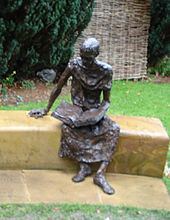Country United Kingdom | ||
 | ||
Similar Church of St Peter‑le‑Bailey, All Saints Church - Oxford, St Michael at the North Gate, St Cross Church - Oxford, Queen's Lane Coffee H | ||
St Peter-in-the-East is a 12th-century church on Queen's Lane, north of the High Street in central Oxford, England. It forms part of St Edmund Hall, one of the Oxford University colleges. It is now deconsecrated and houses the college library for graduates and undergraduates. The churchyard to the north is laid out as a garden and contains a seated bronze statue depicting St Edmund as an impoverished student.
Contents
History
St Peter-in-the-East is believed to be named after the 5th-century church of S. Pietro in Vincoli, Rome, Italy. When the Church of St Peter-le-Bailey was built in precincts of Oxford Castle, this church was renamed St-Peter-in-the-East since it is located near the East Gate of the walled city of Oxford. The Norman parts of the current church were built around 1140 by Robert D'Oilly, who was then Governor of Oxford.
There was a church of St Peter in Oxford before this one, which was mentioned in the Domesday Book of c1085:
the church of St. Peter Oxenford holds of Robert two hides in Haliwelle...It was worth twenty shillings, now it is worth forty...The church passed to the Crown from D'Oilly's heirs. In 1266, King Henry III gave it to Walter de Merton and thus until the 1970s, Merton College held the advowson for the church. The churches at Wolvercote and Holywell were originally chapels of ease of St Peter's.
At present, the building serves as the College library of St. Edmund Hall, University of Oxford. It was deconsecrated and converted in the 1970s.
Church building
The 12th-century church originally consisted of a crypt, chancel, and nave, extending to just beyond the south door. In the 13th century, a north aisle was added to the nave. The church tower was added in the 14th century, and the nave was either heightened or reconstructed to connect with the tower. The windows are mostly 14th century and the door into the tower is 16th century. At the east end of the aisle there is a small chapel dedicated to St Catharine and St Thomas, constructed in the early 16th century
The Lady Chapel (or North, Chapel) was built in the early 13th century. It was donated by Edmund Rich, who later became Archbishop of Canterbury, when he was a resident of the Hall that was subsequently named St Edmund Hall after him. The north window, dating from 1433, was donated by the vicar, Vincent Wyking. It contains some glass from that period and some from the 14th century. The east windows are two 13th century lancets.
